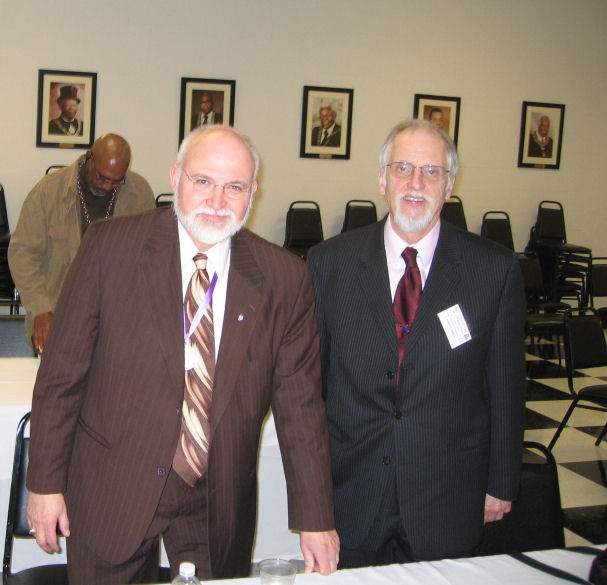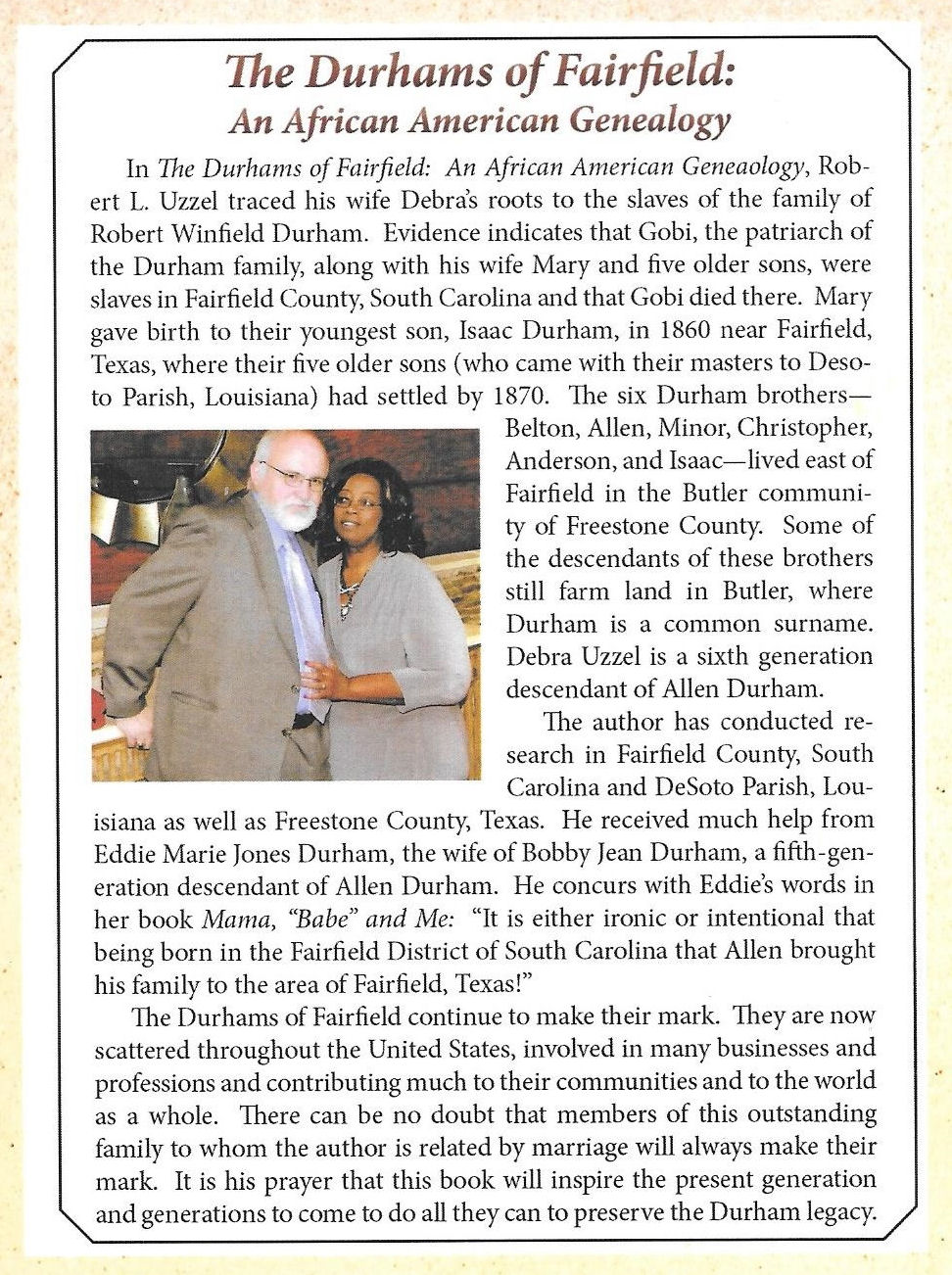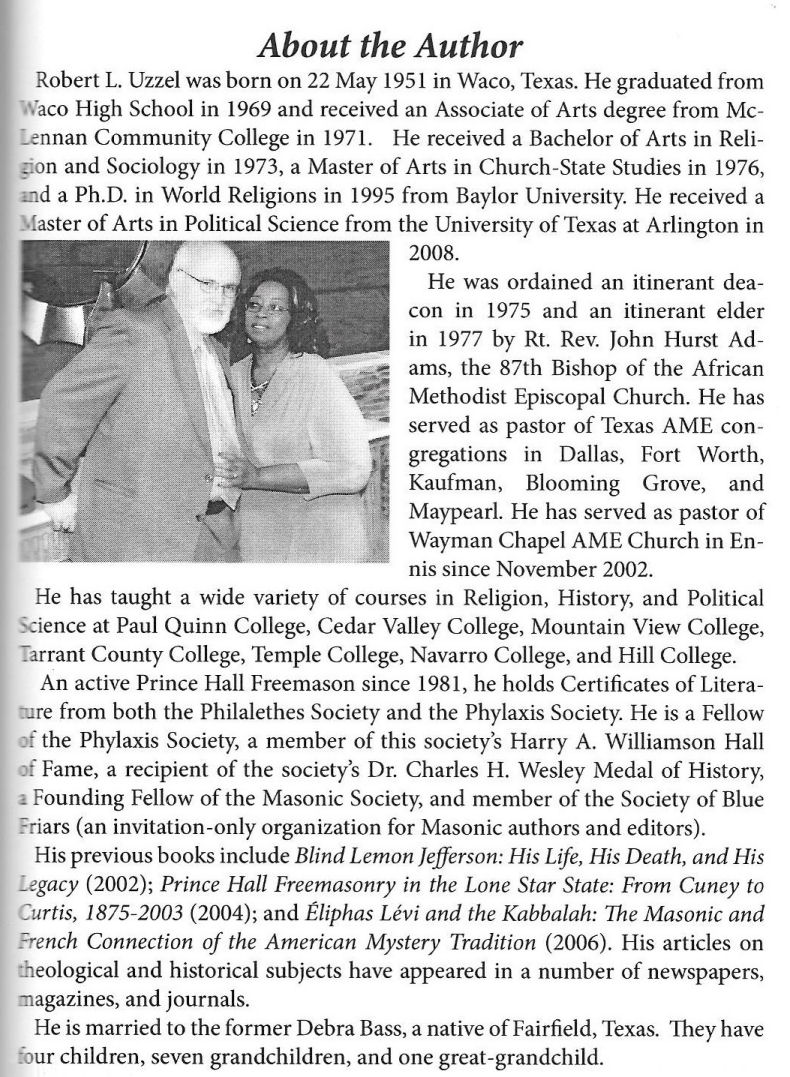The Durhams of Fairfield
By Wor. Bro. Frederic L. Milliken
Dr., Rev., Bro. Robert L. Uzzel and Bro. Frederic L. Milliken
Past Grand Historian of the Most Worshipful Prince Hall Grand Lodge of Texas, Dr. Rev. Bro. Robert L. Uzzel, has a new book out, “The Durhams of Fairfield.” This is Uzzel’s Roots story, tracing his wife’s family genealogy.
The Durhams, Black and White, originated in Fairfield County, South Carolina. Those that were slaves later moved with their Masters to DeSoto Parish, Louisiana. From the early 1850s to 1930 DeSoto Parish was the home of Mansfield Female College, the oldest female college west of the Mississippi river. Uzzel tells us of the famous Civil War Battle of Mansfield in this County on April 8, 1864. Here the Confederates defeated the Union Army and stopped their advance into Texas. The Battle of Pleasant Hill close by the following day again resulted in a Union defeat and forever kept the Civil War out of Texas. One of the prizes the Rebels seized in these victories was the Val Verde Cannon.
From the Parish of DeSoto, Louisiana, after the Emancipation, we follow the African American Durhams to Freestone, County Texas whose County Seat was Fairfield, Texas. There the Val Verde Cannon also found its final resting place. Just down the road apiece from Fairfield was the small town of Butler, Texas where most of the Durhams called home.
It seems almost prophetic, the hand of fate, that the Durhams of Fairfield County, South Carolina should end up in Fairfield, Texas, from Fairfield to Fairfield half way across the nation.
This book was 38 years in the making! Uzzel conducted an exhaustive research of the Durhams over the years. He researched birth certificates, death certificates and funeral programs, marriage licenses and baptismal and church records. He visited numerous libraries and courthouses for information. He mailed out questionnaires, conducted personal interviews, talked to many people via telephone, sent out and received correspondences and conducted long research on the Internet. It can be very difficult to trace the genealogy in the African American community.
In the author’s own words we will post below his journey in the writing of this “Roots” story.
How I Wrote The Durhams of Fairfield
by Dr. R. L. Uzzel
When my fourth book The Durhams of Fairfield: An African American Genealogy was published in 2015, a dream going back nearly four decades came true. The Durhams of Fairfield are truly a great family—a family with a very interesting history. How did I become so interested in this family? I married into it. On 19 February 1977,
I married Debra Bass of Fairfield, Texas. Debra is the daughter of Aldessa Henry Bass, the granddaughter of Gladys Durham Henry, the great granddaughter of Willie Anderson Durham, the great-great granddaughter of Rance Durham, the great-great-great granddaughter of Allen Durham, and the great-great-great-great granddaughter of the African Gobi.
I was born and raised in Waco, Texas and have had a passion for history since childhood. On 14 May 1976, I received my Master of Arts degree in Church-State Studies (an interdisciplinary program involving courses in Religion, History, and Political Science) from Baylor University. My thesis was entitled “The Nation of Islam: Belief and Practice in Light of the American Constitutional Principle of Religious Liberty.” One of my major sources for this work was The Autobiography of Malcolm X by Alex Haley. Later that year, Haley’s most famous book Roots: The Saga of an American Family, was published. I read this book and later watched the television miniseries. Roots is about Haley’s maternal side. At the time of his death in 1992, he was putting together a book on his paternal side. Co-author David Stevens completed the editing of this work and Alex Haley’s Queen: The Story of an American Family was published in 1993. As was the case with Roots, I read Queen and watched the television miniseries. I was inspired to do what Alex Haley did!
On 2 December 1974, I went to work for the Texas Department of Public Welfare (now Health and Human Services) in Teague, Texas. Teague is ten miles from Fairfield, the county seat of Freestone County. I worked as a social worker for the aged, blind, and disabled. My duties included visiting nursing homes, where I assessed the social service needs of clients receiving Texas vendor payments. I also arranged homemaker and chore services that enabled clients to remain in their own homes as an alternative to nursing home placement. I served clients in Teague, Fairfield, Butler, Streetman, Kirvin, and Wortham. The latter community is the hometown of the Texas blues singer Blind Lemon Jefferson (1893-1929). During my first trip to Wortham, I visited the Wortham Black Cemetery (now the Blind Lemon Jefferson Cemetery) and visited this great singer’s grave, which is now regarded as a blues shrine. I resolved to one day write a biography of Lemon. In 2002, my first book Blind Lemon Jefferson: His Life, His Death, and His Legacy was published. One of the nursing homes I served was the Fairview Manor Nursing Center in Fairfield. There I met a nurse named Debra Bass. Debra and I had our first date on 21 October 1976, became engaged on 25 December 1976, and got married on 19 February 1977. We lived for a few weeks in Fairfield, moving from Fairfield to Dallas, from Dallas to Kaufman, from Kaufman to Waco, from Waco to Dallas, and from Dallas to Ennis. We now look forward to returning to the Fairfield area as we approach retirement.
Roots appeared about the time of our marriage. I immediately began asking questions. I found little information on the Bass and Henry families. When I inquired about the lineage of Gladys Durham Henry, however, more information was available. Initially, I assumed that they had come from North Carolina in view of the city of Durham, which was named for Dr. Bartlett Durham, who donated land for a railroad in 1850. Durham is famous as the site of Duke University and the place where Bull Durham tobacco was first manufactured. I did much research on the history of this North Carolina city. However, it soon became evident that the Durham family to which my wife was related did not come from there.
While no member of the Durham family was adept at genealogy, it was commonly reported that the family had come to the Butler community of Freestone County (between Fairfield and Palestine) from Louisiana after the Civil War; and that there were six Durham brothers—Belton, Allen, Minor, Chris, Anderson, and Isaac. Some of the descendants of these brothers still farm land in Butler, where Durham is a common surname. My wife is a sixth-generation descendant of Allen Durham.
Mary Durham, the widow of Belton’s grandson Rev. General Bev Durham, told me that her husband’s great grandfather was an African named Gobi. Johnnie Johnson, Jr., another grandson of Belton, told me that Gobi was a slave in South Carolina and conveyed to me the following legend: “Once, there was a rain spell and they could not work. The straw boss (overseer) and Gobi went hunting for bears. In a bear cave, they uncovered some gold. The straw boss died first. Gobi had sworn never to reveal the whereabouts of the gold. Some men tied Gobi to a tree in a bottom and wrapped a rope around him. Gobi refused to reveal where the gold was hidden, even when surrounded by mosquitoes. As a result, his tongue was torn out by its roots and he was left there to die.” These early interviews pointed to South Carolina and Louisiana as places where the Durhams were slaves. When I asked about a specific county in South Carolina and a specific parish in Louisiana, no one had a clue.
In September 1976, I received my first pastoral appointment in the African Methodist Episcopal Church to Emmanuel AME Church in Dallas. Shortly after our marriage, Debra and I moved to Dallas. During the next four years, I held jobs with the same agency in Fort Worth and Dallas. While employed in Fort Worth, I had a client who was a member of Durham Memorial Church of God in Christ, named for founding pastor General Bev Durham, who died in 1966. Through this client, I met both Mary Durham and Mary Edwards, the sister of Johnnie Johnson, Jr. Mary Edwards, who died in 2012 at the age of 96, was a big help in my research.
During the next few years, I conducted many interviews with older family members and visited both Lone Star Cemetery and Pine Top Cemetery at Butler, obtaining names and dates from tombstones. I went to the Freestone County Courthouse, where I examined birth certificates, death certificates, and marriage licenses. This information was very helpful. However, the fact that none contained the exact county or parish of birth was frustrating. I spent many hours in libraries, researching census records and slave schedules on microfilm. I was able to verify some of the oral history I had obtained. According to the 1870 Freestone County Census, Allen Durham was born in South Carolina around 1836 and his son Rance was born in Louisiana in 1859. This, however, did not answer my question about the specific places of birth. Numerous letters to libraries, genealogical societies, and other resources brought limited results. With the examination of numerous 1850 and 1860 records of these two important southern states, I finally hit pay dirt. I found the majority of Durhams concentrated in Fairfield County, South Carolina and DeSoto Parish, Louisiana.
In 1983, I received a telephone call from Maj. (later Lt. Col.) Donald Smith Durham of Manassas, Virginia. Don was calling in response to a letter I had sent to his brother Thomas in Shreveport that had been forwarded to him. Don (who died in 2006) did much research on his genealogy and was confident that my wife was descended from slaves owned by his ancestors. He confirmed what I had found in my research. Don’s great-great grandfather was Robert Winfield Durham, who died in Fairfield County, South Carolina in 1852. His widow, Mosley Eliza Durham, and three of their sons—Osman Lawrence Durham, Charlton Hightower Durham, and John Franklin Durham– relocated to DeSoto Parish, Louisiana, bringing their slaves with them. Osman had lived for about ten years in Lowndes County, Alabama. Molsey and her three sons are all listed in the DeSoto Parish Census of 1850 and 1860. Don and I exchanged much genealogical information by mail and phone.
I found the fact that the Durhams started their journey in Fairfield County, South Carolina and ended up near Fairfield, Texas to be more than coincidental. In her book Mama, “Babe” and Me, Eddie Marie Jones Durham, the wife of Bobbie Jean Durham, a fifth-generation descendant of Allen Durham, described the residents in two places called Fairfield as “either ironic or intentional.” I first met Eddie when I interviewed Allen’s son Luke Durham, whom her mother had married. She was also a big help with my research.
In 1979, I was appointed to the pastorate of Macedonia AME Church in
Kaufman. As a result, Debra and I relocated from Dallas to Kaufman. In 1981,
I went to work as a social worker at Terrell State Hospital (a psychiatric facility).
During this time, I learned that there was a Durham family living in the community of Avalon, which is located in Ellis County, which borders Kaufman County. I went to visit them in 1983 and interviewed Isiah Durham, the son of Julious Durham and grandson of Chris Durham. I had interviewed Julious in 1980 in a nursing home in Dallas a few months before his death. Isiah confirmed the story I had heard about Chris having a peg leg, stating that he had lost his leg in a boiler accident at Lake Port Cotton Gin in Butler. It was also in 1983 that I conducted an interview with Mitcheola Durham, brother of Julious, at a nursing home in Teague.
Over the years, I have attended a number of Durham Family Reunions, each time giving a lecture about my research and interviewing family members about their personal stories. During the 1980s, the family of Archie Durham, grandson of Allen Durham, held some wonderful gatherings. Archie was a very good friend with much enthusiasm for my research. When he died in 2001 at age 95, I participated in his funeral. However, most of the Durham Family Reunions have been sponsored by the descendants of Isaac Durham, the youngest of the six brothers. In 1999, while teaching at Navarro College in Corsicana, I taught Richard Durham, Jr., the great-great grandson of Isaac. Richard was born on 15 August 1980 and was amazed to learn that his great-great grandfather was born on 15 August 1860. Richard’s genealogical paper revealed that Gobi’s wife Mary was pregnant at the time of his death and gave birth to Isaac shortly after her arrival in Freestone County. Isaac was the only brother born in Texas. The five older brothers were born in South Carolina.
I do not wish to give the impression that I worked on this project non-stop for nearly 40 years. There were years when I did little or nothing on it. I was involved in other research leading up to my 1995 Ph.D. in World Religions from Baylor University and my 2008 M.A. in Political Science from the University of Texas at Arlington. After many difficulties and delays, I was blessed to have the following books published: Blind Lemon Jefferson: His Life, His Death, and His Legacy (2002); Prince Hall Freemasonry in the Lone Star State: From Cuney to Curtis, 1875-2003 (2004); and Éliphas Lévi and the Kabbalah: The Masonic and French Connection of the American Mystery Tradition (2006). I repeatedly put the Durham project aside but always came back to it.
With the advent of the Internet, including such sources as Ancestry.com., my research accelerated. I found much interesting information. In 1870 and 1880, there African American Durhams in both DeSoto Parish, Louisiana and Freestone County, Texas. Some were born in South Carolina and some in Louisiana. There were even a few born in Alabama. The latter were more than likely the slaves of Osman Lawrence Durham.
On 23 August 2003, I made my first trip to DeSoto Parish, Louisiana. On 22-24 August 2012, I made a long-awaited trip to Fairfield County, South Carolina. I returned to DeSoto Parish on 11 March 2013 and participated in the 150th Anniversary of the Battle of Mansfield in DeSoto Parish on 26 April 2014. As a result, I was able to obtain valuable pictures and important interviews. I find it interesting that the Fairfield Memorial Hospital operated in Fairfield, Texas for many years before the building was leased by East Texas Medical Center, while the Fairfield Memorial Hospital continues to operate in Winnsboro, Fairfield County, South Carolina. My book contains pictures of both hospitals. The Val Verde Cannon which was used at the Battle of Mansfield found its permanent home in front of the Freestone County Courthouse in Fairfield but was on display at the 150th Anniversary of the Battle of Mansfield. My book contains pictures of the cannon at both locations.
On 5 March 2014, Eakin Press (the publisher of my Blind Lemon and Prince Hall
books) accepted The Durhams of Fairfield for publication. Much of 2014 was devoted to writing, editing, and proofreading. After a number of delays, my first shipment of books arrived on 5 January 2015 and my first book singing was held for the Ellis County Genealogical Society in Waxahachie on 2 February 2015.
The Durhams of Fairfield continue to make their mark. They are now scattered throughout the United States, involved in many businesses and professions and contributing much to their communities and to the world as a whole. There can be no doubt that members of this outstanding family to whom I am related by marriage will always make their mark. I thank God that my dream has come true and pray that this book will inspire the present generation and generations to come to do all they can to preserve the Durham legacy!
To get this book click on the link below:
http://www.barnesandnoble.com/w/the-durhams-of-fairfield-robert-l-uzzel/1120950796?ean=9781940130774




